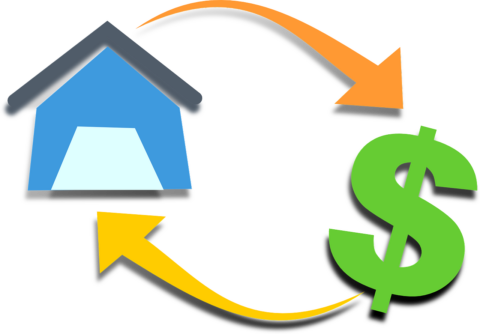It’s no secret that most people will retire without adequate funds to live comfortably during their retirement years.
Today I’m going to share some ways to use the equity in your home to help supplement your retirement income.
Using a portion of the equity from your house could give you the cash you need to invest elsewhere to generate retirement income.
Or… you can elect to have the borrowed funds from a reverse mortgage paid out to you in regular installments — to increase the income you receive during your retirement years.
Here’s how to use funds from a reverse mortgage to supplement your retirement income…
How Reverse Mortgage Works
A reverse mortgage allows you to borrow a small percentage of the available equity in your home to use however you want.
You aren’t required to make repayments on the amount of money you borrow — and what’s more, the money you unlock from your home gives you tax-free cash that can be used in far more effective ways.
- With a traditional mortgage… you use your income to pay down the debt over time.
- With a reverse mortgage… the loan balance grows over time because you are not making monthly mortgage payments.
A reverse mortgage, also known as the home equity conversion mortgage (HECM) in the United States, is a financial product for homeowners 62 or older who have accumulated home equity and want to use this to supplement retirement income. Unlike a conventional forward mortgage, there are no monthly mortgage payments to make. Borrowers are still responsible for paying taxes and insurance on the property and must continue to use the property as a primary residence for the life of the loan. Source
Do You Qualify For A Reverse Mortgage?
A reverse mortgage isn’t based on your income. Instead, the assessment criteria focuses on your age and the amount of equity you have available in your home. The actual amount you can borrow will be different for every applicant.
Most lenders increase the amount you’re able to borrow against your equity as you get older.
For example… if you’re 62, the amount you’re able to borrow against your property will be lower than someone who is 72.
Use this Reverse Mortgage Calculator to see how much money you can get from a reverse mortgage.
How To Use A Reverse Mortgage To Supplement Retirement Income
Once you’ve unlocked some cash from your family home, you can spend that money however you want.
Some lenders will give you the option of having the funds from your reverse mortgage paid to you in monthly installments — which form your supplemental retirement income. For example, you could elect to have an income of $1,600 per month paid to you from the loan proceeds for the next 5 years, as long as you have sufficient equity to cover the borrowing amount.
Other lenders will allow you to withdraw the amount you’ve borrowed as a lump sum to spend however you please. So, you might choose to complete some home renovations to improve the value of your property. Or, you might prefer to invest that money elsewhere to generate an income over time — such as through dividends on stocks or rental income on another property.
If you’re in a position where you haven’t repaid your home mortgage yet, but you’re seeking ways to transition into retirement, then you could choose to pay off your mortgage debt with your new reverse mortgage. The repayments on your regular mortgage would stop — leaving you with more income available each month.
According to Investopedia, these are the 6 ways that you can choose to receive the proceeds when you take out a reverse mortgage:
- Lump sum – Get all the proceeds at once when your loan closes. (This is the only option that comes with a fixed interest rate. The other 5 have adjustable interest rates.)
- Equal monthly payments – For as long as at least one borrower lives in the home as a principal residence, the lender will make steady payments to the borrower.
- Term payments – The lender gives the borrower equal monthly payments for a set period of the borrower’s choosing, such as 10 years.
- Line of credit – Money is available for the homeowner to borrow as needed. The homeowner only pays interest on the amounts actually borrowed from the credit line.
- Equal monthly payments plus a line of credit – The lender provides steady monthly payments for as long as at least one borrower occupies the home as a principal residence. If the borrower needs more money at any point, they can access the line of credit.
- Term payments plus a line of credit – The lender gives the borrower equal monthly payments for a set period of the borrower’s choosing, such as 10 years. If the borrower needs more money during or after that term, they can access the line of credit.
What About The Kids’ Inheritance?
One of the biggest fears that many retirees have about reverse mortgages is that they won’t have anything left to leave the kids once they’re gone.
However, lenders offering these types of loans won’t allow you to unlock all of your available equity — which means you’ll still have plenty left for the kids when the time comes.
For example, let’s assume your property is valued at $200,000 and you’re 62. You could potentially borrow $55,000 against your equity — leaving you with the remaining $145,000 in equity.
In 10 years’ time the property value may have increased to $300,000. Of course, the initial $55,000 you borrowed will have increased to $85,000, but the amount of equity remaining for the kids’ inheritance is still intact.
Who Repays Your Reverse Mortgage?
Most lenders won’t expect you to make any monthly repayments on your reverse mortgage if you don’t want to.
Instead, any interest accumulated on your debt will be capitalized onto the top of the loan. Over time, the amount you owe will slowly increase. However, as the percentage of equity you’re allowed to borrow is quite low, you will always have some remaining equity in your home available.
The object of a reverse mortgage is that you repay the entire amount you owe when you sell your home, or when the last remaining borrower passes away.
If you don’t like the idea of the interest charges being added onto your loan amount, then you could elect to make voluntary interest payments.
Choosing The Right Reverse Mortgage
There are several types of reverse mortgages available — so it’s important to shop around for competitive interest rates and the best loan terms to suit your individual needs.
It’s also wise to seek professional financial advice to determine which reverse mortgage will be best suited to your financial situation.
As long as you’ve done your homework and sought advice, a reverse mortgage can be the ideal way to supplement your retirement income. Once you unlock that cash from your home’s equity, you’re in a position to enjoy your retirement years the way you deserve to.
With input from Financial Advisors, (a Tax Accountant and an Investment Manager), I share helpful tips regarding money and finances — including debt relief, insurance, budgeting, and investing for retirement. My goal is to help you save more, spend less, and invest for the future by sharing honest, tried & true budgeting tips and tools. When I'm not saving for the future and helping others save for theirs, you can find me at the corner of Good News & Fun Times as publisher of The Fun Times Guide (32 fun & helpful websites).






